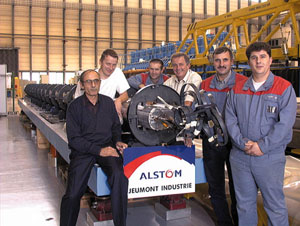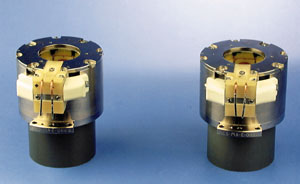With the start-up of CERN’s Large Hadron Collider just five years away, the laboratory’s new flagship accelerator is moving firmly from prototyping to production. R&D is coming to an end and contracts for magnet production are being placed.

The prototyping of the main dipole magnets for the LHC reached a conclusion last year with successful tests of the final prototypes, manufactured in a collaboration between CERN and industry. All dipoles delivered to CERN from now on will be installed in the new accelerator. Dipole prototyping began in 1990 when the machine’s design called for 10 m magnets with a 50 mm aperture and a field of 8.6 T. The initial plan was for all of the prototyping to be carried out in industry, and work was soon under way in five companies.
By 1995, however, it had become apparent that a closer working partnership between CERN and industry was needed for the R&D phase. From then on, collared coils were produced in industry, while assembly and cryostating were carried out at CERN. A hydraulic press was installed at the laboratory to precompress and curve the complete assembly during the welding of the magnets. By this time, two of the initial companies had withdrawn, leaving France’s Alstom-Jeumont consortium, Germany’s Noell, and Italy’s Ansaldo still in the running.
Lattice redesign
A redesign of the LHC lattice soon emerged: the dipole length was increased to 15 m to allow a greater operational margin with a field of 8.3 T and an aperture of 56 mm. Two full-scale prototype collared coils were ordered from each company, and these were assembled into magnets at CERN during the course of 1999 and 2000. All worked satisfactorily, achieving the required field with little training. The second magnet from Alstom Jeumont performed particularly well, reaching 9 T with just a single quench. It also displayed good enough field quality to be used in the accelerator.
Lessons learned from these final prototypes were quickly fed back to the three manufacturers, all of which are now producing a preseries batch of 30 magnets each. The first of these, produced in a collaboration between Alstom-Jeumont and CERN, confirmed the excellent behaviour of the prototype. A close relationship between CERN and industry is being maintained for the start of this phase of production, with industry personnel being based at CERN to assemble the collared coils into magnets. The ultimate goal, however, is for the full production process to be transferred to industry. To this end, CERN has installed a press at each of the three companies. These differ from the one at CERN in that the welding procedure will be automated, whereas at CERN a manual procedure was implemented to give maximum flexibility.

Preseries dipole production will be complete by mid-2003. The call for tender to allocate the remaining production of 1158 magnets was launched in May, with contract adjudication expected for September. When full scale production gets under way, a second coil-winding and curing line is scheduled to be installed at each company, bringing the total production capacity to 10 magnets a week. The last dipole is scheduled to arrive at CERN in July 2005.
Dipoles, however, are not the first LHC magnets to receive the production green light. That honour belongs to the 2464 sextupoles that will correct for slight field imperfections at the extremities of the dipoles. These have been developed by CERN in collaboration with India’s CAT laboratory, resulting in an efficient, low-cost design and two patent applications for ingenious construction methods.
One – a so-called diaphragm centring system – could be used for holding wheels on axles, for example. The other is for an automatic coil-winding machine. Production is to be shared between the Kirloskar Electric Company of Bangalore in India and Spain’s ANTEC, with the Indian consignment forming part of India’s in-kind contribution to the LHC project. A first preseries production of 10 magnets each from India and Spain was tested at CERN in 2000, with a second batch expected soon. Most have performed entirely within specification. These preseries sextupoles have paved the way for full-scale production to start in the middle of this year and the green light has already been given to one of the two firms.
Octupole and decapole magnets will also be used to correct for field imperfections. Fewer are needed because only one in two of the LHC’s main dipoles will be equipped with them. Their production is also shared between an Indian and a European firm – Crompton Greeves and Tesla Engineering respectively. Ten pre-series magnets from each company are expected to undergo acceptance tests at CERN before the middle of the year, and the go -ahead for series production should follow a few months later. Like the dipoles, the LHC’s main quadrupoles are also equipped with corrector magnets. Here the aim is to steer and control the beams precisely. These correctors – dipoles, quadrupoles, sextupoles and octupoles – have now all been ordered from industry. By the end of this year, CERN engineers expect to have a full bouquet of corrector magnets under test.

A total of 392 short straight sections will house the LHC’s main focusing quadrupoles, along with other beam correcting magnets. The main quadrupoles have been designed and prototyped by France’s CEA laboratory at Saclay, which will also be responsible for the technical follow-up in industry. Their integration into fully equipped short straight sections has been taken care of by the neighbouring CNRS-IN2P3 laboratory at Orsay. The contribution of both laboratories is part of France’s host-state contribution to the LHC project.
Short and straight
From 1989 to 1994, CEA-Saclay designed, constructed and successfully tested two prototype quadrupoles to an early design. A further three built to the present LHC design were made and tested between March 2000 and January 2001. All showed highly satisfactory behaviour, with at most one quench on their way to a nominal operating current of 11 870 A, corresponding to a field gradient of 223 T/m. After thermal cycling, all “remember” their training. Moreover, their measured field quality meets expectations, indicating that the design fulfils all requirements for LHC operation.
The German firm Accel has won the contract for producing the quadrupoles, and engineers from Saclay are currently transferring their tooling from France to the Accel plant near Cologne. The first series production quadrupole is expected at CERN by the end of the year. Other magnets and components for the short straight sections will come from all over Europe, leading to a complex logistical puzzle for CERN. The company Balcke-Dürr in Germany has been awarded the contract for constructing the cryostats and assembling the short straight sections.
In addition to the LHC’s main lattice magnets, a large number of specialized magnets, known as insertions, will be employed at the LHC. These will perform specific tasks, such as injecting and ejecting beams, and providing the final focus before the collision points. The LHC’s insertions will be the subject of an article in a future issue of CERN Courier.





